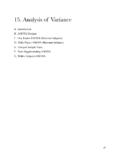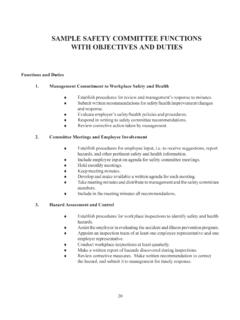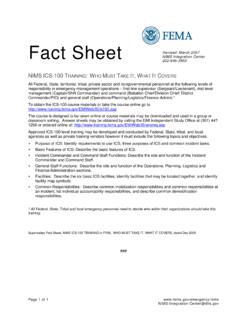Transcription of Online Statistics Education B
1 1. IntroductionThis chapter begins by discussing what Statistics are and why the study of Statistics is important. Subsequent sections cover a variety of topics all basic to the study of Statistics . The only theme common to all of these sections is that they cover concepts and ideas important for other chapters in the are Statistics ? of of Are Statisticsby Mikki HeblLearning the range of applications of situations in which Statistics can be Statistics Statistics include numerical facts and figures. For instance: The largest earthquake measured on the Richter scale. Men are at least 10 times more likely than women to commit murder. One in every 8 South Africans is HIV positive. By the year 2020, there will be 15 people aged 65 and over for every new baby study of Statistics involves math and relies upon calculations of numbers.
2 But it also relies heavily on how the numbers are chosen and how the Statistics are interpreted. For example, consider the following three scenarios and the interpretations based upon the presented Statistics . You will find that the numbers may be right, but the interpretation may be wrong. Try to identify a major flaw with each interpretation before we describe ) A new advertisement for Ben and Jerry's ice cream introduced in late May of last year resulted in a 30% increase in ice cream sales for the following three months. Thus, the advertisement was major flaw is that ice cream consumption generally increases in the months of June, July, and August regardless of advertisements. This effect is called a history effect and leads people to interpret outcomes as the result of one variable when another variable (in this case, one having to do with the passage of time) is actually responsible.
3 2) The more churches in a city, the more crime there is. Thus, churches lead to major flaw is that both increased churches and increased crime rates can be explained by larger populations. In bigger cities, there are both more churches and more crime. This problem, which we will discuss in more detail in Chapter 6, refers to the third-variable problem. Namely, a third variable can cause both situations; however, people erroneously believe that there is a causal relationship between the two primary variables rather than recognize that a third variable can cause both. 3) 75% more interracial marriages are occurring this year than 25 years ago. Thus, our society accepts interracial major flaw is that we don't have the information that we need. What is the rate at which marriages are occurring? Suppose only 1% of marriages 25 years ago were interracial and so now of marriages are interracial ( is 75% higher than 1).
4 But this latter number is hardly evidence suggesting the acceptability of interracial marriages. In addition, the statistic provided does not rule out the possibility that the number of interracial marriages has seen dramatic fluctuations over the years and this year is not the highest. Again, there is simply not enough information to understand fully the impact of the a whole, these examples show that Statistics are not only facts and figures; they are something more than that. In the broadest sense, Statistics refers to a range of techniques and procedures for analyzing, interpreting, displaying, and making decisions based on of Statisticsby Mikki HeblLearning examples of Statistics encountered in everyday examples of how Statistics can lend credibility to an argumentLike most people, you probably feel that it is important to take control of your life.
5 But what does this mean? Partly, it means being able to properly evaluate the data and claims that bombard you every day. If you cannot distinguish good from faulty reasoning, then you are vulnerable to manipulation and to decisions that are not in your best interest. Statistics provides tools that you need in order to react intelligently to information you hear or read. In this sense, Statistics is one of the most important things that you can be more specific, here are some claims that we have heard on several occasions. (We are not saying that each one of these claims is true!) 4 out of 5 dentists recommend Dentine. Almost 85% of lung cancers in men and 45% in women are tobacco-related. Condoms are effective 94% of the time. Native Americans are significantly more likely to be hit crossing the street than are people of other ethnicities.
6 People tend to be more persuasive when they look others directly in the eye and speak loudly and quickly. Women make 75 cents to every dollar a man makes when they work the same job. A surprising new study shows that eating egg whites can increase one's life span. People predict that it is very unlikely there will ever be another baseball player with a batting average over 400. There is an 80% chance that in a room full of 30 people that at least two people will share the same birthday. of all Statistics are made up on the of these claims are statistical in character. We suspect that some of them sound familiar; if not, we bet that you have heard other claims like them. Notice how diverse the examples are. They come from psychology, health, law, sports, business, etc. Indeed, data and data interpretation show up in discourse from virtually every facet of contemporary are often presented in an effort to add credibility to an argument or advice.
7 You can see this by paying attention to television advertisements. Many of the numbers thrown about in this way do not represent careful statistical analysis. They can be misleading and push you into decisions that you might find cause to regret. For these reasons, learning about Statistics is a long step towards taking control of your life. (It is not, of course, the only step needed for this purpose.) The present electronic textbook is designed to help you learn statistical essentials. It will make you into an intelligent consumer of statistical can take the first step right away. To be an intelligent consumer of Statistics , your first reflex must be to question the Statistics that you encounter. The British Prime Minister Benjamin Disraeli is quoted by Mark Twain as having said, There are three kinds of lies -- lies, damned lies, and Statistics .
8 This quote reminds us why it is so important to understand Statistics . So let us invite you to reform your statistical habits from now on. No longer will you blindly accept numbers or findings. Instead, you will begin to think about the numbers, their sources, and most importantly, the procedures used to generate have put the emphasis on defending ourselves against fraudulent claims wrapped up as Statistics . We close this section on a more positive note. Just as important as detecting the deceptive use of Statistics is the appreciation of the proper use of Statistics . You must also learn to recognize statistical evidence that supports a stated conclusion. Statistics are all around you, sometimes used well, sometimes not. We must learn how to distinguish the two cases. Now let us get to work!14 Descriptive Statisticsby Mikki HeblPrerequisites noneLearning descriptive Statistics between descriptive Statistics and inferential statisticsDescriptive Statistics are numbers that are used to summarize and describe data.
9 The word data refers to the information that has been collected from an experiment, a survey, an historical record, etc. (By the way, data is plural. One piece of information is called a datum. ) If we are analyzing birth certificates, for example, a descriptive statistic might be the percentage of certificates issued in New York State, or the average age of the mother. Any other number we choose to compute also counts as a descriptive statistic for the data from which the statistic is computed. Several descriptive Statistics are often used at one time to give a full picture of the Statistics are just descriptive. They do not involve generalizing beyond the data at hand. Generalizing from our data to another set of cases is the business of inferential Statistics , which you'll be studying in another section.
10 Here we focus on (mere) descriptive descriptive Statistics are shown in Table 1. The table shows the average salaries for various occupations in the United States in 1999. 15 Table 1. Average salaries for various occupations in 1999.$112,760pediatricians$106,130dentis ts$100,090podiatrists$76,140physicists$5 3,410architects,$49,720school, clinical, and counseling psychologists$47,910flight attendants$39,560elementary school teachers$38,710police officers$18,980floral designersDescriptive Statistics like these offer insight into American society. It is interesting to note, for example, that we pay the people who educate our children and who protect our citizens a great deal less than we pay people who take care of our feet or our more descriptive Statistics , consider Table 2. It shows the number of unmarried men per 100 unmarried women in Metro Areas in 1990.











